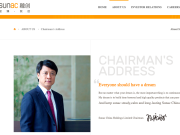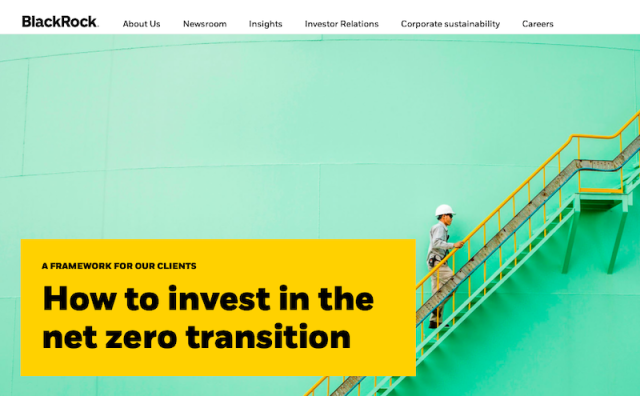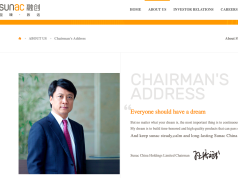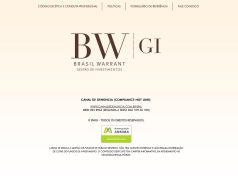BlackRock Letter to Investors: How to Invest in the Net Zero Transition
22nd April 2022 | Hong Kong
BlackRock, the world’s largest asset manager with more than $10 trillion Assets under Management, has released a letter to investors on how to invest in the net zero transition. BlackRock: “We are hearing a range of questions about the transition from clients– how do I safeguard my portfolio against physical risk and transition risk? How do I measure and implement my net zero commitments? Which companies will thrive in the transition and which won’t? How do I capitalize on the promise of new technologies? How will different hydrocarbon companies adapt to the transition and how will that impact my portfolio? These questions are of growing importance to long-term investors – but also difficult to answer as the economy undergoes such a profound transformation.” View full letter below or on BlackRock Website
“ how do I safeguard my portfolio against physical risk and transition risk “
BlackRock Letter to Investors: How to Invest in the Net Zero Transition

Dear Client,
We are writing to you as a client who has expressed interest in the net zero transition. As the transition becomes increasingly pivotal to your long-term investment goals, it is our responsibility to help provide you with the answers and the tools you need to help address it in your portfolio. The choice of how to approach the transition, as always, remains with you, and as your fiduciary, we commit to helping guide and advise you as it unfolds.
We are hearing a range of questions about the transition from clients – how do I safeguard my portfolio against physical risk and transition risk? How do I measure and implement my net zero commitments? Which companies will thrive in the transition and which won’t? How do I capitalize on the promise of new technologies? How will different hydrocarbon companies adapt to the transition and how will that impact my portfolio? These questions are of growing importance to long-term investors – but also difficult to answer as the economy undergoes such a profound transformation.
Decarbonization is proceeding at different speeds across different parts of the economy and the world. The shocks we see in the energy sector today are one example of the challenges the transition poses. Increased investment in the supply of renewables outpaced the reduced investment in fossil fuels. Now, increased demand for fossil fuels in the restart of economic activity and impaired supply have driven up the price and use of gas, oil, and coal. There will be periods like this when traditional energy performs well – periods that should not be seen as counter to the transition, but as part of it.
At the same time, the net zero transition is also advancing. The share of countries committed to net zero has swelled from less than 10 percent to 95 percent of global emissions. In the beginnings of a tectonic shift of capital, investors have moved their money into sustainable investments at six times the growth rate of traditional investments, with assets globally now totaling $4 trillion across all ESG categories. And there has been striking change across carbon-intensive industries, from energy to heavy industry to agriculture, to decarbonize and remake their businesses.
The speed and shape of the transition are deeply uncertain, and it will take decades to play out. It is essential that governments, businesses, and finance work together to manage the transition in an orderly fashion, ensuring reliable energy supply and cost along the way.
The ambition and effectiveness of government policy will be a major factor in determining the future role for hydrocarbons. Effective, long-term planning is necessary to deliver cost-efficient clean energy alternatives at scale. Without it, hydrocarbons will continue to play a central role in the global economy for a much longer time. To date, public policy has primarily focused on limiting hydrocarbon supply but has not done enough to address demand – for example, by retooling energy-intensive industries or accelerating adoption of zero-carbon energy sources – resulting in higher energy prices in some instances. And as we have seen in emerging markets, rising natural gas prices can also drive increased use of coal.
Today there is a significant degree of uncertainty about the transition. The issue, however, is no longer whether the net zero transition will happen but how – and what that means for your portfolio. Our focus on understanding the how of the net zero transition is driven, as always, by our role as a fiduciary. It is based on our abiding conviction that long-term investors must consider the implications on their portfolios of both physical climate risk and the transition to net zero in the real economy, and that by taking these factors into account, they can more effectively manage risk, seize new investment opportunities, and achieve better long-term returns. We delve deeper into these topics in a new paper from the BlackRock Investment Institute, “Managing the net zero transition.”
We hope to answer your questions about the transition and offer you a comprehensive set of options to help you address them – whether it’s tilting your broad market strategies to be more climate-aware, investing in carbon-intensive companies that are transforming their businesses, or gaining exposure to the new technologies and business models of a net zero world. We are committed to providing the full range of investment choices to help you find the best path for you and your stakeholders, and regardless of which approach you choose, we are profoundly excited to help you navigate this transformation.
We have taken a number of steps over the past two years to help you address the transition: integrating ESG risk considerations into our active investment process, introducing more than 200 new sustainable funds, building Aladdin® Climate to help you understand physical and transition risk in your portfolio; forming Decarbonization Partners to invest in innovative decarbonization technologies and businesses; and establishing a heightened scrutiny framework to help manage exposure to climate-related risk in active portfolios.
We are working to help address some of the most difficult questions in decarbonization. Our Climate Finance Partnership, a global consortium of governments, philanthropies, and institutional investors, is focused on investing in climate infrastructure in emerging markets. And the BlackRock Foundation has partnered with Breakthrough Energy Catalyst, in order to help increase the commercial viability of critical climate technologies.
We have also taken action to increase transparency for our clients, including publishing implied temperature rise metrics for our ETFs and public index funds. You can read a more detailed update here.
In 2022 and beyond, we aim to:
- Build and deliver the industry’s most sophisticated transition tools, analytics, and portfolio advice, powered by Aladdin and designed to help investors to invest amidst high uncertainty about the pace of change in policy and the real economy.
- Offer you a framework for thinking about how to invest in the transition – a spectrum of “navigate, drive, and invent.” With capital already flowing fast to green technologies, we believe there is also a significant investment opportunity for managers who can identify the carbon-intensive companies with the best strategies for decarbonization.
- Establish a new capability to bring together BlackRock’s efforts focused on transition finance and to incubate transition-focused investment strategies.
Helping guide you through the transition
Clients have long expected their asset manager to have a sophisticated understanding of the direction of interest rates, inflation, and macroeconomic growth. Increasingly, they expect the same sophisticated understanding of the net-zero transition.
For investors to navigate the transition, they need to be able to measure and model it. That’s why we have been building Aladdin Climate – a collection of data, models, analytics and tools to help investors understand, report, and act on physical and transition risk in their portfolios and capture related opportunities.
Aladdin Climate analyzes how securities and portfolios are impacted by and contribute to forward-looking climate scenarios and decarbonization pathways. The technology integrates these analytics into a platform that investors use to manage risk and investments. These climate metrics are delivered alongside traditional financial metrics and portfolio construction capabilities, providing investors with a consistent way to evaluate risks and identify new investment opportunities.
Starting with Aladdin – and drawing on BlackRock’s proprietary insights and tools across public and private markets, we aim to build the industry’s clearest map of how the transition is likely to unfold across technologies, sectors, and regions. The BlackRock Transition Scenario will put our analytical and modeling capabilities at the fingertips of portfolio managers and clients to help illuminate the path to navigate, drive and invent the transition.
We are also augmenting our sustainable investing capabilities through tools such as BlackRock Sustainable Investing Intelligence™ – our proprietary framework that goes beyond traditional financial accounting metrics to identify companies best prepared to mitigate risks and capture opportunities associated with the transition.
In addition, BlackRock Investment Stewardship’s engagement with companies about their transition plans is an essential aspect of informing our views on the transition and promoting long-term value for our clients. We ask every company to help its investors understand how it may be impacted by climate-related risk and opportunities, and how these factors are considered in a manner consistent with the company’s business model and sector. BlackRock Investment Stewardship Global Principles contain further details on our approach.
A transition framework: navigate, drive, and invent
After hundreds of conversations with clients to inform our thinking, we have developed a framework to help you achieve your investment objectives as the transition unfolds. While we offer you a variety of ways to approach the transition, all of them recognize that a clear understanding of the transition is vital to achieving better long-term returns.
Markets are already bearing this argument out – for example, our research has shown that more sustainable companies are seeing their cost of capital fall. And while short time periods are not determinative, it is striking that in 2021, 70 percent of a selection of broad-market ESG indices outperformed their non-ESG counterparts, with average outperformance of over 100 basis points.
However, we also believe that markets are only beginning to price in the effects of the climate transition on asset prices, creating a significant opportunity for our clients. Indeed, understanding sustainability characteristics is key to our ability to generate alpha, and as the transition accelerates, an understanding of these characteristics will be even more pivotal to outperformance.
Navigate
At the center of any sound investment approach is an understanding not only of how the world looks today, but how it might look tomorrow. That question increasingly hinges on understanding the net zero transition – and having the right approach to navigate it effectively.
Virtually every client is asking: how do I navigate the transition to manage risk and capture opportunity? How do I think about climate not only in terms of green technologies, but across the whole economy? How do I reconcile the ongoing role of fossil fuels – even the need for continued upstream investment – with the push to accelerate clean energy deployment? These are increasingly existential questions for portfolio construction because no investor can afford to ignore the transition as it accelerates.
Navigation isn’t just about making an allocation to sustainable investments. It is about understanding as precisely as possible how the multiple forces of decarbonization will impact your entire portfolio – for example, how evolving technology, energy prices, government policy, and other factors interact to paint a picture of how the transition is unfolding, with implications at the security, sector, and portfolio level.
BlackRock already offers you a number of ways to navigate, including transition benchmarks and next-generation tilts that leverage proprietary data, research and insights – customizing and optimizing to lean into financially-material decarbonization and ESG objectives aligned to our clients’ goals. Our active portfolios are ESG-integrated, which means that portfolio managers take sustainability-related characteristics of issuers into account in their investment decisions.
In 2022, we are committing to offer you more targeted ways to invest in line with the way decarbonization is projected to unfold.
- More strategies to enable investors to “green the core” of their portfolio by accessing climate-aware broad-market exposures and drawing on BlackRock Sustainable Investing Intelligence, including potential options for investors focused on retirement.
- We also plan to offer new fundamental and systematic active strategies and to continue to expand our iShares® strategies to include climate benchmarks.
- We will expand our Portfolio Consulting and Outsourced Chief Investment Officer capabilities to incorporate climate transition analytics and allow for greater customization to enable our clients to achieve their unique sustainability objectives.
Drive
Given the inevitability of the net zero transition, we believe navigation should be the default posture of investors. But we are hearing from more and more clients who want to do more than just understand how the transition may unfold and adjust their portfolios accordingly. They want to help drive it forward, positioning themselves to capture value while contributing to accelerated progress.
In this context, many of you are asking us: should my ambition be to remove as much carbon as possible from my portfolio today, or should I invest in carbon-intensive sectors that are in the process of going green? To paraphrase one climate-focused global investor, having a zero-carbon portfolio today doesn’t necessarily drive decarbonization tomorrow.
Capital markets are already channeling capital to companies with green business models, such as producers of renewable energy, suppliers of electric mobility technology, or companies focused on nature-based solutions. We believe an underappreciated opportunity for investors seeking to drive the transition lies in identifying carbon-intensive companies that are positioning themselves to lead decarbonization within their industries.
The transition to net zero, of course, will take decades. The global economy will continue to rely on fossil fuels as emissions-intensive sectors like electricity, industry, and transport work to decarbonize. Some incumbents will be displaced by new technologies or more agile startups, and some will lose out to competitors who are decarbonizing more successfully. But many other incumbents will thrive, providing important investment opportunities for our clients, and successful decarbonization plans by these companies will be critical to an orderly transition.
What might driving successful decarbonization look like at the industry level? For a utility, it might mean negotiating the early closure of a coal-fired power plant and using free cash flow to invest in grid-scale battery technology. For a steel producer, it might mean replacing traditional blast furnaces with electric arc furnaces. For an automaker, it might be committing to all-electric vehicle designs faster than its competitors.
BlackRock already provides a number of ways for clients to drive the transition – from one of the world’s leading renewable power franchises, to our Climate Finance Partnership, to a range of thematic strategies.
In 2022, we are deepening our focus on the question of decarbonization across our investment platform, integrating it more deeply into our existing strategies, and offering new active public-markets strategies, index thematic strategies, and green bond strategies. In addition, our private-markets strategies are increasingly focused on helping clients access a range of transition-focused opportunities, both in renewables and in companies seeking to decarbonize.
Invent
Finally, clients will have enormous opportunities to invest in the technologies and businesses needed to invent major aspects of a truly zero-emissions economy. Clients are asking, how can I invest in the climate tech of the future? What are the climate unicorns of the 21st century that will have the biggest impact on the transition and generate outsize returns?
Many of these technologies exist but are not yet economically competitive – such as green hydrogen, carbon capture, green cement, or sustainable aviation fuel. Capital is necessary to commercialize these new technologies and invent others, and many of you have told us you see this area as one of the most exciting investment opportunities of the coming decades.
Last year, we announced the formation of Decarbonization Partners with Temasek, which will seek to make investments in early-stage growth companies targeting proven, next-generation renewable and mobility technology. And just last week, we announced the dedicated investment team, which has already begun identifying an exciting pipeline of investment opportunities.
This year, we will establish a new capability to bring together BlackRock’s efforts focused on transition finance – a hub for select strategies related to the transition; an incubator for new investment strategies; and a forum for BlackRock to connect with companies, academics, and other organizations to better understand the transition and seek the best investment opportunities on behalf of our clients.
Conclusion
The transition is a process that will unfold over many years. It will take careful planning and coordinated action among government, business and investors. We believe there is still a great deal to learn about how best to move forward, and your voice and your insights will be essential. We look forward to learning and working together, and we hope you will consider joining us for a summit on transition finance, which we will host later this year.
We are committed to being the world’s leading advisor and expert on investing in the net zero transition. We are committed to giving you the most sophisticated, up-to-date analytics and the deepest understanding of how the transition will unfold. And we are committed to helping you select the investment options that are right for you and your stakeholders. It is our privilege to work with you to navigate, drive, and invent this economic and financial transformation.
Sign Up / Register
Caproasia Users
- Manage $20 million to $3 billion of assets
- Invest $3 million to $300 million
- Advise institutions, billionaires, UHNWs & HNWs
Caproasia Platforms | 11,000 Investors & Advisors
- Caproasia.com
- Caproasia Access
- Caproasia Events
- The Financial Centre | Find Services
- Membership
- Family Office Circle
- Professional Investor Circle
- Investor Relations Network
Monthly Roundtable & Networking
Family Office Programs
The 2025 Investment Day
- March - Hong Kong
- March - Singapore
- July - Hong Kong
- July - Singapore
- Sept- Hong Kong
- Sept - Singapore
- Oct- Hong Kong
- Nov - Singapore
- Visit: The Investment Day | Register: Click here
Caproasia Summits
- The Institutional Investor Summit
- The Investment / Alternatives Summit
- The Private Wealth Summit
- The Family Office Summit
- The CEO & Entrepreneur Summit
- The Capital Markets Summit
- The ESG / Sustainable Investment Summit









































